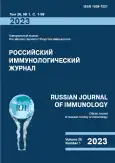Экспрессия PD-1 на популяциях Т-клеток периферической крови пациентов с аллергическими заболеваниями
- Авторы: Блинова Е.А.1, Галдина В.А.2, Сухова Н.М.1, Демина Д.В.1
-
Учреждения:
- ФГБНУ «Научно-исследовательский институт клинической и фундаментальной иммунологии»
- ФГАОУ ВО «Новосибирский национальный исследовательский государственный университет»
- Выпуск: Том 26, № 1 (2023)
- Страницы: 63-68
- Раздел: КРАТКИЕ СООБЩЕНИЯ
- URL: https://journals.rcsi.science/1028-7221/article/view/120225
- DOI: https://doi.org/10.46235/1028-7221-1197-PEO
- ID: 120225
Цитировать
Полный текст
Аннотация
В основе патогенеза аллергических заболеваний лежит активация Th2-звена иммунного ответа. Как известно, Т-клеточный ответ на антиген регулируется различными ко-стимуляторными и ингибиторными сигналами, к ингибиторным рецепторам относятся молекулы PD-1 и Tim-3. Взаимодействие рецептора PD-1 с его лигандами приводит к подавлению активации, пролиферации Т-клеток и продукции ими цитокинов. При хронических бактериальных и вирусных инфекциях повышенная экспрессия PD-1 и Tim-3 на Т-клетках является маркером клеточного «истощения», так как у позитивных по данным ингибиторным рецепторам клеткам снижена продукция цитокинов. Участие ко-ингибиторного рецептора PD-1 в патогенезе аллергических заболеваний изучено недостаточно, имеющиеся на сегодняшний день в литературе данные немногочисленны и противоречивы. Поэтому целью данного исследования стала оценка уровня экспрессии коингибиторных рецепторов PD-1 и Tim-3 на CD4+ и CD8+Т-клетках, а также экспрессии PD-1 на аллерген-специфических Th2A-клетках при аллергической бронхиальной астме (БА) и аллергическом рините (АР) вне сезона поллинации.
Для фенотипирования клеток периферической крови доноров и пациентов с аллергическими заболеваниями, оценки экспрессии маркеров PD-1, Tim-3 использовали метод проточной цитофлуорометрии. В исследование было включено 7 пациентов с аллергической БА вне обострения, 10 пациентов с АР и 14 здоровых индивидуумов без аллергии. Установлено, что в периферической крови пациентов с БА и АР число CD4+ и CD8+, экспрессирующих молекулу PD-1, находилось на уровне значений здоровых индивидуумов. Снижение CD4+ клеток, экспрессирующих Tim-3, наблюдалось только в группе пациентов с АР, что может быть связано как с отсутствием пыльцевых аллергенов, так и ремиссией заболевания. Содержание аллерген-специфических Тh2A-клеток (CD4+CD45RO+CD27-CRTh2+CD161+) у пациентов с АР и БА было повышено относительно группы контроля, что говорит о патогенетической значимости данной популяции для аллергических заболеваний. Однако уровень экспрессии PD-1 на Тh2A-клетках, так же как и на основных субпопуляциях Т-клеток был сопоставим с донорскими значениями. Что может предполагать, что PD-1 может выступать не только как маркер «истощения», как это было показано при хронических вирусных инфекциях, но и отражать статус активации различных субпопуляций Т-клеток, в том числе аллерген-специфических Th2A-клеток при аллергии.
Полный текст
Открыть статью на сайте журналаОб авторах
Елена Андреевна Блинова
ФГБНУ «Научно-исследовательский институт клинической и фундаментальной иммунологии»
Автор, ответственный за переписку.
Email: blinovaelena-85@yandex.ru
ORCID iD: 0000-0003-3327-3630
к.б.н., старший научный сотрудник лаборатории клинической иммунопатологии ФГБНУ «Научно-исследовательский институт клинической и фундаментальной иммунологии»
Россия, г. НовосибирскВиктория Александровна Галдина
ФГАОУ ВО «Новосибирский национальный исследовательский государственный университет»
Email: vikagaldina@gmail.com
студентка ФГАОУ ВО «Новосибирский национальный исследовательский государственный университет»
Россия, г. НовосибирскНаталья Михайловна Сухова
ФГБНУ «Научно-исследовательский институт клинической и фундаментальной иммунологии»
Email: suchovanatalia@yandex.ru
ординатор ФГБНУ «Научно-исследовательский институт клинической и фундаментальной иммунологии»
Россия, г. НовосибирскДарья Владимировна Демина
ФГБНУ «Научно-исследовательский институт клинической и фундаментальной иммунологии»
Email: immunology@mail.ru
к.м.н., заведующая отделением аллергологии клиники иммунопатологии ФГБНУ «Научно-исследовательский институт клинической и фундаментальной иммунологии»
Россия, г. НовосибирскСписок литературы
- Anderson A.C., Joller N., Kuchroo V.K. Lag-3, Tim-3, and TIGIT: Co-inhibitory receptors with specialized functions in immune regulation. Immunity, 2016, Vol. 44, no. 5, pp. 989-1004.
- Boussiotis V.A., Patsoukis N. Effects of PD-1 Signaling on Immunometabolic Reprogramming. Immunometabolism, 2022, Vol. 4, no. 2, e220007. doi: 10.20900/immunometab20220007.
- Cosmi L., Maggi L., Santarlasci V., Capone M., Cardilicchia E., Frosali F., Querci V., Angeli R., Matucci A., Fambrini M., Liotta F., Parronchi P., Maggi E., Romagnani S., Annunziato F. Identification of a novel subset of human circulating memory CD4+ T cells that produce both IL-17A and IL-4. J. Allergy Clin. Immunol., 2010, Vol. 125, no. 1, pp. 222-230.
- Mosayebian A., Koohini Z., Hossein-Nataj H., Abediankenari S., Abedi S., Asgarian-Omran H. Elevated expression of Tim-3 and PD-1 Immune checkpoint receptors on T-CD4+ lymphocytes of patients with asthma. Iran J. Allergy Asthma Immunol., 2018, Vol. 17, no. 6, pp. 517-525.
- Riley J.L. PD-1 signaling in primary T cells. Immunol. Rev., 2009, Vol. 229, no. 1, pp. 114-125.
- Rosskopf S., Jahn-Schmid B., Schmetterer K.G., Zlabinger G.J., Steinberger P. PD-1 has a unique capacity to inhibit allergen-specific human CD4+ T cell responses. Sci. Rep., 2018, Vol. 8, no. 1, 13543. doi: 10.1038/s41598-018-31757-z.
- Russell R.J., Brightling C. Pathogenesis of asthma: implications for precision medicine. Clin. Sci., 2017, Vol. 131, no. 14, pp. 1723-1735.
- Tang F., Wang F., An L., Wang X. Upregulation of Tim-3 on CD4(+) T cells is associated with Th1/Th2 imbalance in patients with allergic asthma. Int. J. Clin. Exp. Med., 2015, Vol. 8, no. 3, pp. 3809-3816.
- Wambre E., Bajzik V., deLong J.H., O’Brien K., Nguyen Q.A., Speake C., Gersuk V.H., deBerg H.A., Whalen E., Ni C., Farrington M., Jeong D., Robinson D., Linsley P.S., Vickery B.P., Kwok W.W. A phenotypically and functionally distinct human TH2 cell subpopulation is associated with allergic disorders. Sci. Transl. Med., 2017, Vol. 9, no. 401, eaam9171. doi: 10.1126/scitranslmed.aam9171.
- Wang S.H., Zissler U.M., Buettner M., Heine S., Heldner A., Kotz S., Pechtold L., Kau J., Plaschke M., Ullmann J.T., Guerth F., Oelsner M., Alessandrini F., Blank S., Chaker A.M., Schmidt-Weber C.B., Jakwerth C.A. An exhausted phenotype of TH 2 cells is primed by allergen exposure, but not reinforced by allergen-specific immunotherapy. Allergy, 2021, Vol. 76, no. 9, pp. 2827-2839.
Дополнительные файлы







